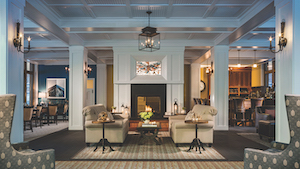
With summer fast approaching, many traditional hotels have started gearing up for an expected increase in both occupancy and activities at their properties. But for seasonal resorts like The Inn at Diamond Cove, such efforts have been in place for months and are essential to ensure a successful summer.
The hotel—which is located off the coast of Maine on Great Diamond Island in Casco Bay and can only be reached by ferry or boat from Portland’s Old Port district—opens its doors in late May and closes in mid-October. However, in between there’s no shortage of planned activities for guests.
Formerly army barracks that were part of Fort McKinley—a military base built between 1891 and 1907 to defend Portland Harbor during the Spanish American War—the Inn first opened in 2015 after being restored with attention to historic detail. It includes 42 condos—the majority of which are suites—with kitchens and balconies, wooden porches, a swimming pool, and cabana bar.

General Manager Erik O’Brien emphasized the importance of effectively ramping up transient staff for the hotel, which is managed by Portsmouth, New Hampshire-based Colwen Hotels and is a member of Historic Hotels of America.
“One of the things that we want to do from a customer engagement standpoint is bring in our team a little earlier so we can give them the right training because it takes time. I’ve put together a program to train anyone that will move to the island for the season, and we’ve already hired them so that they’re ready to go when the lights turn on for us,” he said.
O’Brien pointed out that many of the workers at the hotel, and particularly its waterfront restaurant Diamond’s Edge, are international students that are secured through the J-1 and H2B Visa programs.
The hotel “takes pride in participating in the J-1 program,” according to O’Brien. He further emphasized the diversity of the workforce.
“It’s for foreign exchange students, and these students come from anywhere as far as Bulgaria, Romania, the Czech Republic, as well as Columbia, Argentina, and Peru. We try to work with a lot of the South American countries and European countries,” he said.
Meanwhile, O’Brien noted the H2B program represents a different type of visa, “which is essentially professionals from other countries.”
He continued, “A lot of our chefs, cooks or housekeeping [workers] come from the H2B program.”
O’Brien touted the benefits of these programs and acknowledged he is putting a big focus on creating group activities, such as a baseball game, for these workers to keep them engaged.
“When you’re isolated on the island you are limited in what you can do. So, we’re working on a really great activity schedule where every month we do something as a team, and we take them out. I’m working [on building a schedule] to keep our employee engagement up and to appreciate them because they do a lot of work for us during the time that they’re here,” he said.
O’Brien—who noted July and August are peak months for the resort—talked specifically about some of the activities that are being added to the hotel’s annual event calendar. Some examples include Trivia Tuesdays in the lobby of the hotel, movie night by the pool, which includes a BBQ, and a Fourth of July parade with decorated golfcarts that concludes at the hotel. In addition, guests have access to walking trails, secluded beaches, tennis, yoga, kayaking, and paddleboarding.
O’Brien touted the resort as a unique getaway for guests to leave it all behind, while acknowledging that cell phone service can be a bit of an issue.
“I like to market this as a small inn where you can completely unplug. It’s a true place to really feel like you’re far away, but you’re not because it’s a 20- or 30-minute boat ride into town,” he said.
Finally, O’Brien noted that the hotel is expecting a busy season with advance bookings outpacing last year at this time. He also noted there has been a concerted effort to drive rate back up to pre-COVID levels. As an example, he noted a suite during peak season will now garner roughly $750 a night, which is still considerably less than other nearby locations, according to O’Brien.
“At some point we have to break away from [COVID rates] just like any other hotel. So, we’re trying to work through that by saying, ‘What else can we provide for our guests this year?’ I think the market has changed where we don’t need to discount rates anymore,” he said.
Finally, O’Brien estimated that roughly 60 percent of the hotel’s guests are return visitors, including many from the West Coast of the United States.
“We’ve had a lot of return guests last year and this year that were guests before COVID. People are starting to feel more comfortable now, so they’re reaching out and sharing how much they love the island,” he said.











